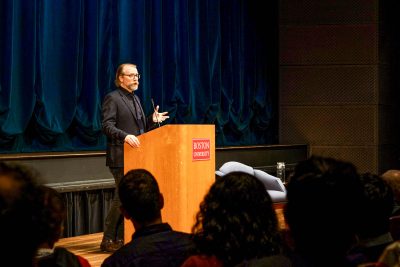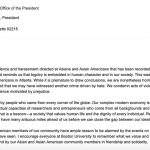
Award-winning author George Saunders revealed his behind-the-scenes process and tips when writing to a well-attended Tsai Performance Center audience as part of the Creative Writing Program’s Ha Jin Visiting Lecturer series Tuesday.
Saunders is well known for his numerous short stories, compiled in collections such as “Pastoralia” and “Tenth of December,” as well as his full-length novel, “Lincoln in the Bardo,” which was published in February 2017.
Reasoning that nobody has ever left a reading feeling like the author read too little, he chose to spend the majority of his time imparting wisdom to the audience about the writing process.
Catherine Flora Con, program coordinator for BU’s Creative Writing Program, said she had seen Saunders speak prior to his visit to the Tsai Performance Center and believed every BU student could find value in his talk.
Con said that “any BU student [who] has dreams of becoming a writer or any sort of artist or [has] any sort of dreams really” could benefit from Saunders’ words of wisdom.
“He’s so inspiring,” she said.
Early on in his career, Saunders said he desperately tried to emulate his hero, Ernest Hemingway. He said he deeply repressed the humor and wit evident in his work because he sought to write more “serious” works of literature. It was only after absentmindedly writing a series of explicit poems at work that Saunders finally realized where his talents lay.
Ha Jin, English professor in BU’s Creative Writing Program and a writer, described Saunders’ writing as “zany and sometimes surreal.”
Saunders’ signature stories feature his humor. Saunders explained that he sought to “delete” his sense of humor, blue collar status and fascination with pop culture when writing. He said at the talk that his breakthrough came when he realized that it was essential to “welcome all parts of the self to the table.”
“His writing is really hopeful. It’s full of empathy,” Con said. “He himself talks a lot about the voice as a means to empathy — in that literary fiction can do what movies and other forms of storytelling can’t do, which is to get directly into the head of a character.”
Following his “eureka” moment, Saunders said to the audience that his writing process evolved into a refined process. Once Saunders has gotten through a first draft, he said he puts it away for a while before coming back to it.
When he gets back to it, he said he actively tries to view the work like a fresh-eyed reader rather than the creator of the work — an essential skill that he said takes practice.
As he reads, Saunders said he visualizes a meter in his head with an arrow moving from positive to negative. When he reaches material he doesn’t particularly like, he begins to work with it.
Saunders likened the experience to that of a parent trying to figure out what’s wrong with their begrudging child. After some pushing, he finally figures out what the problem is. Once he can accept it, he’s able to fix it and move forward.
Saunders also noted that he is a firm believer in the idea that a draft gets 10 percent better every time you revise it.
“He works very hard,” Jin said of his contemporary. “Every sentence, every paragraph. He is really a clean, superb writer.”
Derek Barbosa, a freshman in the College of Engineering, said he found another element of Saunders’ process to be very useful.
“Once you reach a certain block and you’re stuck in your writing, it’s because your original idea is almost rejecting where you’re going,” Barbosa said, reiterating what he learned from Saunders.
Saunders said he doesn’t see writer’s block as a bad thing and instead as a chance to re-evaluate where you’re taking the piece. For him, taking all these steps into consideration has yielded better results.
His first novel, “Lincoln in the Bardo,” was awarded the 2017 Man Booker Prize. Saunders said he had envisioned this experimental novel after driving by Abraham Lincoln’s grave in Springfield, Illinois, during former President Bill Clinton’s years in office. The novel tells of the death and postmortem tribulations of Abraham Lincoln’s son Willie.
Saunders said he kept coming back to the idea at various points in his career, but deemed himself unable to write the full story. In 2012, when musing about the idea once again, Saunders said he reasoned that if he kept putting off the novel, his tombstone would read, “avoided that which he most longed to do.”
“For many years he viewed himself mainly as a short story writer,” Jin said of the novel. “This was a breakthrough.”
Following the lecture and a Q&A session, Saunders hosted a signing for attendees. At the signing, he took the time to engage in conversation with everyone.
Looking back on the lecture, Barbosa said his major takeaway was Saunders’ writing process, which can serve as a guideline for when he gets frustrated with his writing.
“Saunders wasn’t really beating around the bush,” Barbosa said. “Sometimes you just have to wade it out. Writing is not some mystical, mythical process.”




